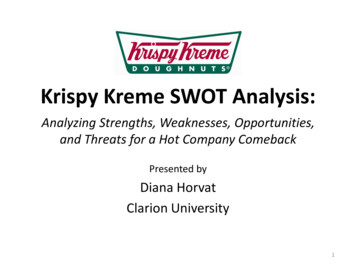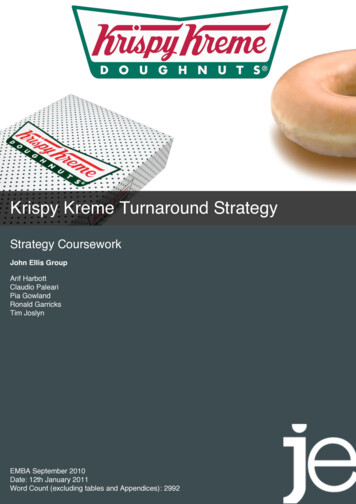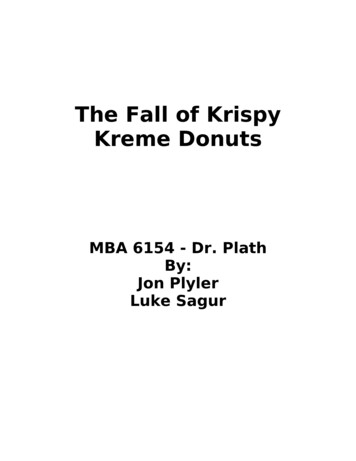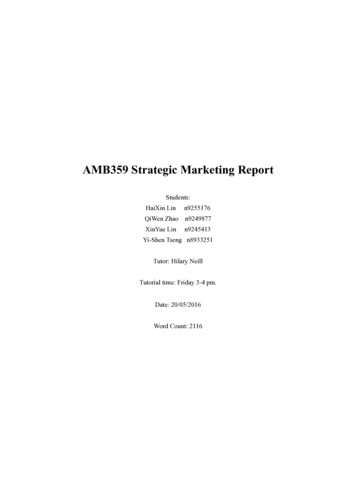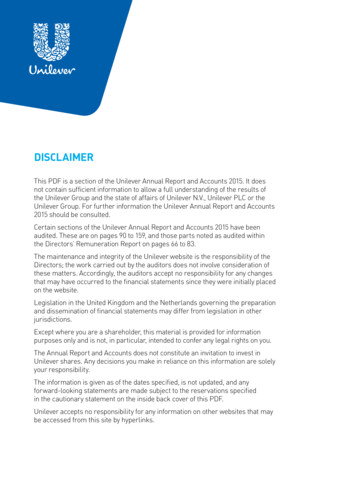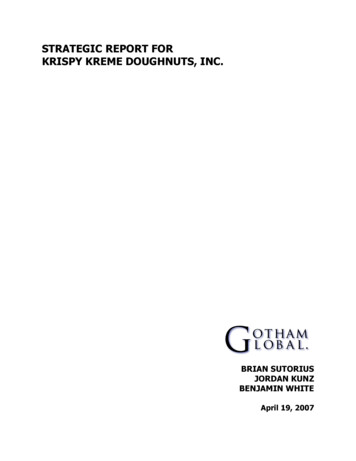
Transcription
STRATEGIC REPORT FORKRISPY KREME DOUGHNUTS, INC.BRIAN SUTORIUSJORDAN KUNZBENJAMIN WHITEApril 19, 2007
TABLE OF CONTENTSEXECUTIVE SUMMARY2COMPANY BACKGROUND4COMPETIT IVE ANALYSISI N TER NA L R IVA LR Y6E N TRY8S UBS TI TUT ESANDC O MP LE MEN TS9S UPP LI ER P O WER11B UY ER P O WE R12SWOT ANALYSIS13FINANCIAL ANALYSISR EVE N UESAN DS TO CK P RIC EC OS TSAN DM ARGI NS1517STRATEGIC ISSUES AND REC OMMENDATIONSS TOR ES20M EN U22B RAN D251
E XECUTIVE S UMMARYKrispy Kreme Doughnuts, Inc. began in 1937 as a doughnut shop that sold its productsout of a store window in North Carolina. Today, the company operates 395 storesworldwide, including 235 in the United States and the rest in 10 foreign countries. Thecompany belongs to the restaurant industry and competes in the fast food and fastcasual sectors, which are subject to high competition. Companies such as Dunkin’Donuts, Tim Hortons, and Starbucks compete with Krispy Kreme for market share onthe basis of pricing, product differentiation, and expansion through franchises.Krispy Kreme went public in 2000, with one of the most successful Initial PublicOfferings of the year. Trading under the ticker symbol KKD, the company stock rosefrom 21 to its peak of 49.37 in 2003 and then began a tragic slide that lasted throughmost of 2005. As famous as its successful opening was, Krispy Kreme is more notoriousfor its overexpansion in the face of declining demand over those two years. Thecompany expanded aggressively across the country as low-carbohydrate diets becamepopular, and the company’s trademark doughnuts were labeled as health risks. In theyears since, the company has closed many of its domestic stores and focused itsexpansion strategy on overseas locations.In this report, Gotham Global separates Krispy Kreme’s strategic issues into three parts:Sales, Menu and Brand. The first part targets the company’s expansion policy, bothdomestic and abroad. Stores are both franchised and company-owned, and can beclassified as either a factory store or a satellite store. Gotham Global recommends thatKrispy Kreme maintain its franchise-to-company-owned ratio of 67% as it expandsabroad, and to consider developing markets like metropolitan China and India. GothamGlobal also suggests that underperforming domestic satellite stores be closed and thatthe satellite store model be discontinued. The company also sells its products to off-siteretailers for resale, and 32% of annual sales come from these locations. Krispy Kreme’sproducts are often poorly represented off-site, and Gotham Global recommends aredesign of the in-store kiosk to incorporate heating technology, so that the trademarkHot Doughnuts Now experience can be had.2
The second part, Menu, evaluates the company’s products on two levels: health andvariety. With regards to health, Krispy Kreme should not make sacrifices to its entiremenu in order to satisfy certain health guidelines. The majority of its customers comefor a doughnut, which is widely regarded as unhealthy in the first place. However, ascities across the United States ban the use of trans fats in restaurants, Gotham Globalurges Krispy Kreme to develop new recipes that contain no trans fats. Our company alsoencourages the company to expand their product offerings without cluttering the menu.Breakfast items, such as bagels, egg sandwiches, and juices are proven successes in thefast food and fast-casual sectors: fast food hamburger chain Jack in the Box saw salesdouble after they began selling breakfast items 24 hours a day. Their addition to themenu would increase sales (bagels especially, as they are regarded as healthieralternatives). Finally, “premium” coffee sales must be increased to raise profit margins,and up-selling a doughnut to a “combo” that includes coffee can accomplish this.Finally, Gotham Global recognizes that Krispy Kreme has a strong brand that connotesquality. Traditionally, the company has used grassroots marketing as its main form ofadvertising, but Gotham Global suggests a new advertising campaign designed toincrease store visits. Targeted billboards in high-traffic areas and seasonal promotionsfor limited-edition products are recommended along the company’s existing strategy ofcommunity involvement to promote word-of-mouth. A standard rule on handing outfree doughnuts straight out of the machine should be put in place so as to minimizeprofit losses. Gotham Global suggests coordinating an annual or biannual “DoughnutDay” in which customers receive a free doughnut. This can be tied to community eventsto strengthen the brand’s reputation.3
C OMPANY B ACKGROUNDIn 1937, Vernon Rudolph began selling homemade doughnuts to local groceries forresale in Winston-Salem, North Carolina. His doughnuts were based on a recipe hisuncle had obtained from Louisiana, and they were unique in their inclusion of yeast. Theyeast allowed the dough to rise, which gave the doughnuts a light, airy composition,different from the usual cake doughnuts. This secret ingredient proved successful and itdidn’t take much time before Rudolph started selling doughnuts straight to customersfrom a hole he cut in his wall. The success of his doughnut operation forced Rudolph toexpand, and by the 1950s, it had grown to a small chain of family-owned doughnutshops. Rudolph was committed to quality and consistency. Each doughnut shop usedthe same original recipe, but the doughnuts were still handmade at each location. Toenforce a standard of quality, the company opened a plant dedicated to producing anddistributing dry doughnut mix to each shop. The company also engineered andmanufactured doughnut-making machinery for regulating doughnut production. Thisautomation allowed the company to enjoy steady growth throughout the 1950s and1960s in the Southeast. The doughnut machinery, ingredient mix, and corporate imagewere refined during this period, and are nearly the same today as they were back then.Rudolph passed away in 1973, and company growth slowed for a while, until theBeatrice Foods Company acquired Krispy Kreme in 1976. Although some reorganizationtook place, the company’s headquarters remained in Winston-Salem. The BeatriceFoods Company was a major presence in the food market and a household name untilthe leveraged buyout raids of the 1980s. The bulk of their brands and assets becameConAgra Foods, which is still today one of the country’s largest packaged foodscompanies. A group of franchisees bought Krispy Kreme back from Beatrice Foods in1982, and refocused the company’s energies on the hot doughnut experience. TheDoughnut Theatre concept, where customers could watch freshly baked doughnuts rolloff the assembly line from behind a glass window, was popularized during this time. Thecompany began to expand again, and it ventured out of the Southeast. In 1996, a storewas opened in New York City, and in 1999, a store was opened in California. KrispyKreme was a national brand at this point, and took the opportunity to go public.4
The Initial Public Offering took place on April 5, 2000. The company was traded on theNASDAQ under the ticker symbol KREM. 3 million shares were sold at 21 each, whichthen increased to 36 the next day. This solidified KREM as having one of the bestperforming initial public offerings of the year. A little over a year later, on May 17 2001,the company switched to trading on the New York Stock Exchange under the symbolKKD. The stock hit its peak of 49.37 in 2003 and then began a slide that lasted throughmost of 2005. Krispy Kreme’s problematic downfall has been a popular business storyfor the past couple years. KremeKo, the company responsible for overseeing KrispyKreme franchises in Canada, filed for bankruptcy in 2005 (whereas the first Canadianstore was opened in 2001). This prompted the closing of many other Canadian stores,though some remain open today. A similar situation occurred in New York, whenDynamic Doughnuts, responsible for managing Krispy Kreme franchises outside of NewYork City, closed most of its stores.The company has also experienced major closings in the Southwest: the RigelCorporation, responsible for all franchises in Arizona and New Mexico, filed forbankruptcy in 2006 and closed all its stores. The company terminated its contracts withGreat Circle Family Foods, a prominent franchisee in Southern California, in early 2006on allegations of missed payments. Great Circle countered with a lawsuit later that year,and the settlement resulted in the reinstatement of their contracts. Lawsuits were filedagainst the company for misreporting profits and “channel stuffing” (delivering moredoughnuts to suppliers than ordered at the end of a reporting period, while still bookingthe increased revenue, then taking the unsold doughnuts back at the beginning of thenext reporting period).Krispy Kreme now produces about 5.5 million doughnuts a day and over 2 billion a year.The company operates 235 United States stores that span 43 states, and offers theirdoughnuts in mega-chains like Wal-Mart, Target, and major gas stations. They havefranchises in 10 foreign countries including Australia, Japan, South Korea, and theUnited Kingdom1. Their menu includes their famous original glazed doughnut, specialtydoughnuts, coffee and espresso-based drinks, and frozen beverages.5
C OMPETITIVE A NA LYSISI N TER NA L R IVA LR YKrispy Kreme competes in two distinct markets. The first, and most obvious, is therestaurant industry, which is broken into three segments: fast food, fast-casual, and fullservice. The first two are primarily separated by the quality of food and atmosphere. Thecompany’s limited menu offerings and store décor suggest its place in the fast foodsector, but the quality of their doughnuts is more in line with the quality of food servedat fast-casual locations. This industry has performed well in the last year, despiteunderperforming the broader market. Restaurants are benefiting from the recent trendaway from at-home dining: about half of total food expenditures of the last year werespent outside of the household, and the percentage is expected to increase.Krispy Kreme’s main competitors in the fast food and fast-casual markets are Dunkin’Donuts and Tim Hortons. Dunkin’ Donuts is privately held, with over 5,300 stores in 34states, and foreign locations in 30 countries. Tim Hortons was recently spun off fromWendy’s, going public in March 2006. Its United States presence is modest at 336 storescentered around the Great Lakes region, but its Canadian presence is much moresignificant: 2,710 stores, more than even McDonald’s. Product differentiation is key inthis market. Tim Hortons more closely parallels Krispy Kreme with its product offeringof doughnuts, baked goods, and coffee. Dunkin’ Donuts recently introduced a newemphasis on their coffee-based beverages, but continues to enjoy the majority of thedoughnut industry’s market share. The coffee segment of fast food and fast-casualrestaurants is an important one. Currently, only 15% of Krispy Kreme’s sales come frombeverages1, which is significantly lower than the industry average. The company sells a“premium” private label brand of coffee under the Krispy Kreme name, allowing theprofit margins on coffee to be much greater than the margins on doughnuts. GothamGlobal encourages the company to increase coffee sales. At the recent Annual Meeting,the idea of selling a doughnut and coffee “combo” was suggested. Attaching coffee salesto already-healthy doughnut sales is a good idea and should be followed through. Theincreased focus on coffee sales will put the company up against coffee chains like6
Starbucks and Caribou Coffee in addition to direct competitor Dunkin’ Donuts. Whilethese companies represent a strong market force, consumers in the fast food and fastcasual restaurant market have low switching costs, and the unique product mix of highquality doughnuts and premium coffees can attract customers from rival companies.Krispy Kreme also sells their donuts to supermarkets, gas stations, and retailers(including Wal-Mart) for resale. In this market of pre-packaged doughnuts, thecompany faces competition from the likes of Little Debbie, Hostess, and Entenmann’s.These companies have a wide range of product offerings, extending beyond doughnutsto snack cakes, cookies, and pastries. Krispy Kreme’s offerings are less spread out thanits competitors, so promoting the Original Hot Glazed and other strong sellers in thismarket would leverage the power of the company’s reputation towards competitivesales.An issue with off-premises sales is freshness. One of Krispy Kreme’s strongest brandassets is the Hot Doughnuts Now sign, signaling fresh and warm products. This signhas proven to be a significant influence on impulse purchases. Doughnuts left on a shelfhave no way of recreating the same fresh, hot experience as doughnuts manufacturedon-site. Off-premises kiosks should be redesigned to incorporate heating technology,and have a stronger aesthetic tie-in to the corporate brand and image. The company hasexperimented in the past with such a heating technology, referred to internally as“tunnel ovens.” These heating setups were tested in 2002 in company satellite stores(stores without on-site doughnut production equipment) as a method of providing theHot Doughnuts Now experience remotely. All but three were shut down as ofFebruary 2006 due to poor financial performance and an unfinished technology1. Itwould be unwise to dive right back in to a proven failure, but refining the tunnel ovenand deploying it not just to satellite stores but also doughnut kiosks is recommended.The issue of consumer preferences for healthy foods is one that will be revisitedthroughout this report. It is worth noting here that the doughnut industry as a whole hasbeen declining in recent years in part due to health issues. Substitute products such asbagels and English muffins have been on the rise. Panera Bread, which serves premium7
breads
expansion strategy on overseas locations. In this report, Gotham Global separates Krispy Kreme’s strategic issues into three parts: Sales, Menu and Brand. The first part targets the company’s expansion policy, both domestic and abroad. Stores are both franchised and company-owned, and can beFile Size: 1MBPage Count: 28
